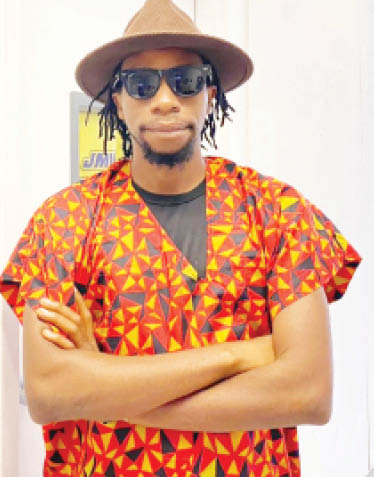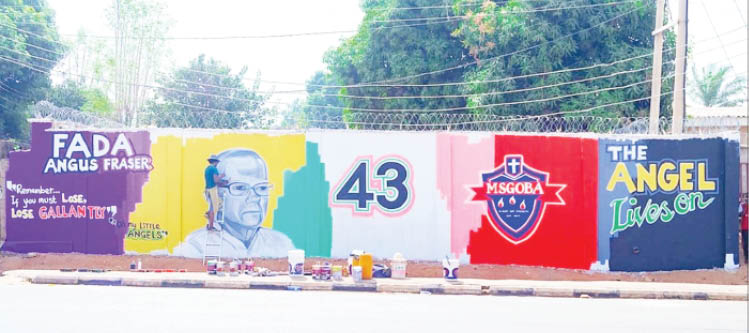Murals are expensive kind of art – MrArtist
Ver “MrArtist” Ikeseh is a Benue-born artist with a love for creating murals that evoke the emotions of his audience and the communities he works in. In this interview, he gives an insight into his creativity as a mural artist. What initially drew you to the world of murals and collages as your chosen […]

Ver “MrArtist” Ikeseh
Ver “MrArtist” Ikeseh is a Benue-born artist with a love for creating murals that evoke the emotions of his audience and the communities he works in. In this interview, he gives an insight into his creativity as a mural artist.
What initially drew you to the world of murals and collages as your chosen artistic medium?
As a little child, I have always wished to use my art to make a difference in my little environment. Even as a little child, I would make drawings and paste on walls and shelves. I was so excited when people complimented my art. I felt so elated and did more as I grew older and my world expanded. This passion propelled me to study fine arts professionally in the university. My passion of reaching out with my art has birthed 920 Project where I aim to paint murals in 920 communities across Africa. I paint the murals with teens from the communities, and I use the sessions to teach them how to paint murals.

Can you share the story behind your very first mural or collage project and how it impacted your career?
It is very difficult for me to remember my first mural because I did several wall designs during my undergraduate days. However, my first major wall mural was in Ekiti State during my NYSC Orientation at the Ese-Emure Camp. I painted a composition that encompassed the various participants. That included the corps members, NYSC staff, security personnel and the government.
- TCN fire incident: Kebbi gov seeks probe over alleged sabotage
- I have no money, but I am very happy – Prof. A.T. Abdullahi (former Deputy Gov, Kano State)
How do you select the themes and subjects for your mural projects? What inspires your choices?
Murals are an expensive kind of art. This is because there are few professional muralist artists and the cost of professional paints are quite high. Most of the communities I work in are ones who the inhabitants can’t afford murals. These are people who are still trying to carter for their basic amenities and murals are not even on their target list. These communities need wall aesthetics the most because they have the most dilapidated structures however, they can’t afford them. So, when I take these murals to them unsolicited, they smile back at me. Sometimes, I use faces of people from the immediate community.
Can you describe a particularly challenging mural or collage project you’ve worked on and how you overcame the difficulties?
One of my worst experiences was when I sought for permission to do a mural at the International Airport in Abuja on a project I believe was related to the environment – human trafficking, and I was turned down. I was asked to pay for it because they looked at it as a commercial. All my explanations fell on deaf ears and they insisted that I must pay. I felt really bad. Again, one of my most cherished murals on a Canada High Commission property was taken down by government authorities in Abuja and I really felt insulted. How did I overcome it? For the one at the airport, I went somewhere else and did the painting and for the one taken down by task force, a letter has gotten to the Minister of the Federal Capital Territory and we are waiting for an explanation about the unlawful incidence, we are also demanding a compensation and an apology with an authorization never to take it off if it’s repainted.
Are there any specific cultural or historical influences that frequently appear in your mural and collage work?
As a graduate of the Ahmadu Bello University, the Zaria School “Natural Synthesis” has an effect on my work. As a result, my environment is always reflective in my work. My collages exhibit my environment both in the pasted prints and fabrics. And my murals reflect cultural themes, as well as the “everyday human faces” drawn from my immediate society. Some of my murals are participatory and painted alongside children and youth for social change. Some of the themes influenced by other participants are cultural, historical, religious and political; which is reoccurring.
Could you walk us through your creative process, from the initial concept to the final installation of a mural or collage?
A typical day for me varies. Some days, it’s always business as usual while some days are more of brain work, calculations and strategizing while other days are more of physical work which I must have discussed the ideas and timelines with my clients. I work with a team who assist me through the processes. I paint murals as commissions and as a way to raise funds to donate murals in slums and rural communities as my community service. I achieve all these with the help of my team. My typical work day starts as early as possible and I make sure I’m at the location for inspection prior to the day of work. On work days, I report early in the morning before 8am.
How do you approach collaborating with clients or communities when creating public murals?
I am very open to collaborating. This has helped my work grow. For instance, once I go to a new city or environment, I reach out to the local artists and request a collaboration. This helps me easily overcome the hassles of logistics and other unforeseen circumstances.
Can you share a memorable collaboration experience?
I collaborated with Moh Awudu and we painted a mural in Accra, Ghana. It was an awesome experience.
Can you discuss any specific mural or collage projects that have had a significant personal or emotional impact on you?
The FADA Fraser mural in Makurdi has done the magic for me. The mural went viral online and on several traditional media from print to TVs and to radio stations. This happened probably because I celebrated a selfless catholic priest who lived selflessly in Makurdi for 43 years. He has passed on but his legacies live on. Before then, my most prestigious mural was a contract with the Canadian High Commission, Abuja. I painted a mural for them at Maitama and so far, that is my single highest paid mural. Prior to that, I also got a deal with Alliance Francais and Goethe Institute and they funded a part of my “920 Project” which includes painting murals across Africa.
What advice would you give to aspiring mural and collage artists looking to pursue a career in this field?
The best piece of advice for me is, just be consistent and passionate about what you do. Sleep it, eat it, and wake it till it becomes a part of you. Just be consistent. Another one I find amazing and people shy away from is “Fake it till you make it”. This quote seems negative on the surface but when you analyse it objectively, it’s just a way of encouraging you to keep pushing towards your dream until you get there. For instance, you might be an amateur artist who has just started out, however you can decide to start emulating professional artists in style, techniques, modes of negotiations, pricing, exhibitions, and media coverages and so on. The aforementioned are things amateur artists do not consciously work towards. So, faking it till you make it in this context means you are planning ahead and working practically towards becoming that professional artist you admire.
What are your future aspirations and projects in the world of mural and collage art?
My dream is to paint the world and if I can’t cover the world in paint, then I would be pleased if I can paint every part of the world in portions. I also dream to give a TED Talk, feature on CNN’s African Voices, BBC Africa and on similar platforms to increase my reach and inspire more minds. For the future, I want to work for very big organisations which also translates to a lot of publicity and cash, it will help me gain publicity and visibility for my 920 project which is a lifetime commitment to paint 920 communities across Africa.
